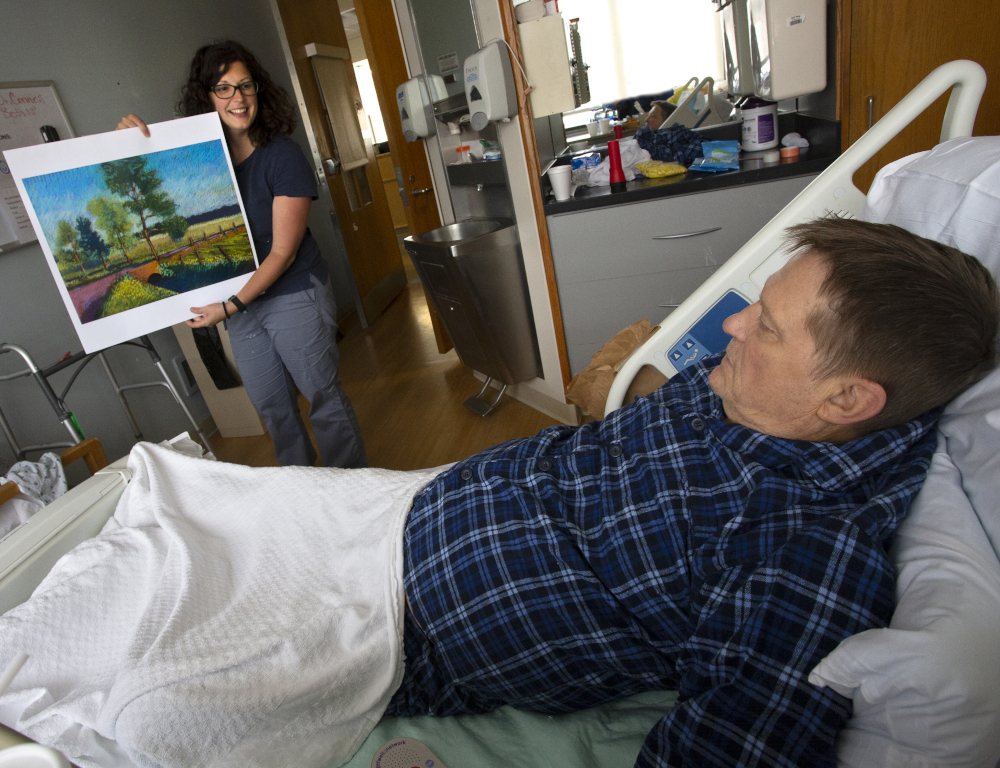Artwork may help improve patients' perceptions of their hospital experience

Patients' perceptions of the hospital they're being treated in may be improved by the type of artwork hanging in hospital rooms, according to Penn State College of Medicine researchers. Artwork could be a low-cost way to help improve patient satisfaction, which is increasingly linked to financial reimbursements hospitals receive for their services.
The researchers examined the effects on hospitalized patients with cancer of having a locally produced, framed painting on the wall in their line of sight. In this experiment, patients who agreed to participate were randomly assigned to one of three groups: those able to choose the painting, those to whom a painting was randomly assigned and those who had a white dry erase board but no painting. The researchers published their findings in the August edition of The Journal of Hospital Medicine.
A total of 186 patients at Penn State Cancer Institute participated in the study: 74 chose the painting in their rooms, 69 had a painting randomly assigned and 43 had a whiteboard. The researchers visited the patients three times during their stay – within 24 hours of being admitted, within 24 to 48 hours of their first visit to the patient, and within 24 to 48 hours of their second visit – and objectively measured the patients' anxiety, mood, depression and sense of control. They also compared pain levels, qualify of life, length of stay and perceptions of the hospital environment using the patients' health records and a survey used to assess health care rooms. Though the differences between the patients' health outcomes in each group were not statistically significant, for the two groups that had artwork there was a positive difference in their perceptions of the hospital environment.
“Our results demonstrate a successful therapeutic application of the arts in a clinical setting, and we used a rigorous research design that is not typically seen in arts research,” said Daniel George, associate professor of medical humanities. George said there are important practical ramifications to the finding that having prints of local artwork in one's room — a relatively simple and cheap ‘intervention' — might improve inpatients' perceptions of the institution.
“It is relevant to hospital administrators who are under increasing pressure to improve care quality and the patient experience. People often find medical environments stark and uninviting, and personalizing a patient's choice of artwork is a way to humanize hospital rooms and perhaps make them feel warmer, more inviting, and less ‘medical.' Our findings are also relevant for rehab facilities, skilled nursing facilities and other settings,” George said.
While this study was conducted with cancer patients, the researchers believe that non-cancer patients could react similarly to use of artwork.
The study's limitations include a higher participation rate for women, incomplete data from patients who switched rooms, artwork not being hung uniformly due to variation in room styles, and the study being conducted at only one hospital.
Future research could focus on comparing use of artwork to other art-based programs like music or incorporating artists in different ways.
“It's perhaps unsurprising that artwork doesn't measurably reduce things like pain, drug use or length of hospital stays for people undergoing profoundly painful and arduous cancer treatments,” George said. “We would have loved to move the needle on some of these outcomes, and perhaps we can in the future by improving aspects of the intervention. For instance, we would like to partner with members of the local arts community to train members of the care team to use the artwork as a means of sparking deeper conversations with patients.”
The National Endowment for the Arts funded this research.
Other researchers on this study are Claire de Boer, director, Kienle Center and Center Stage Arts in Health; Lorna Davis, research assistant; Joel Hammer, research assistant; Margaret Hopkins, research project manager; Tonya King, professor of biostatistics; and Dr. Michael Green, professor of humanities, all at Penn State College of Medicine.
If you're having trouble accessing this content, or would like it in another format, please email Penn State Health Marketing & Communications.
